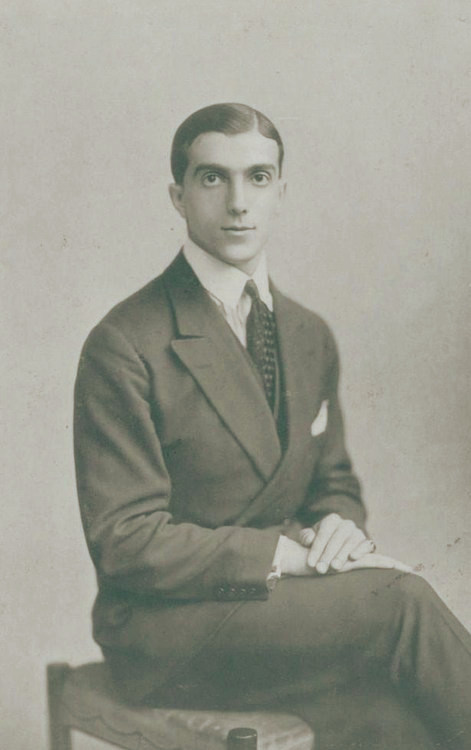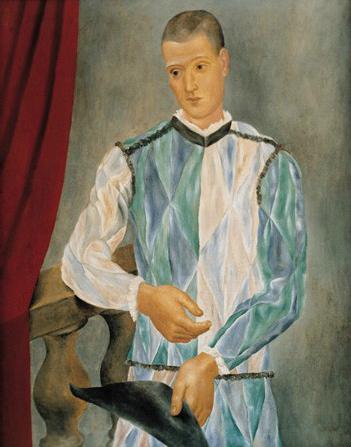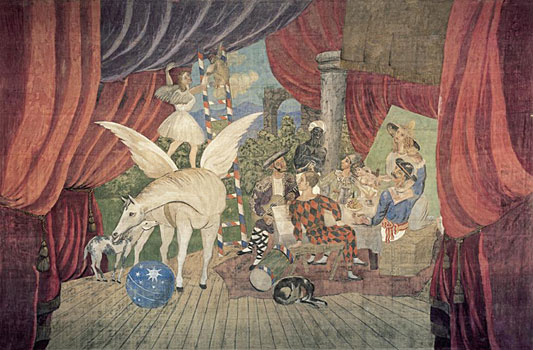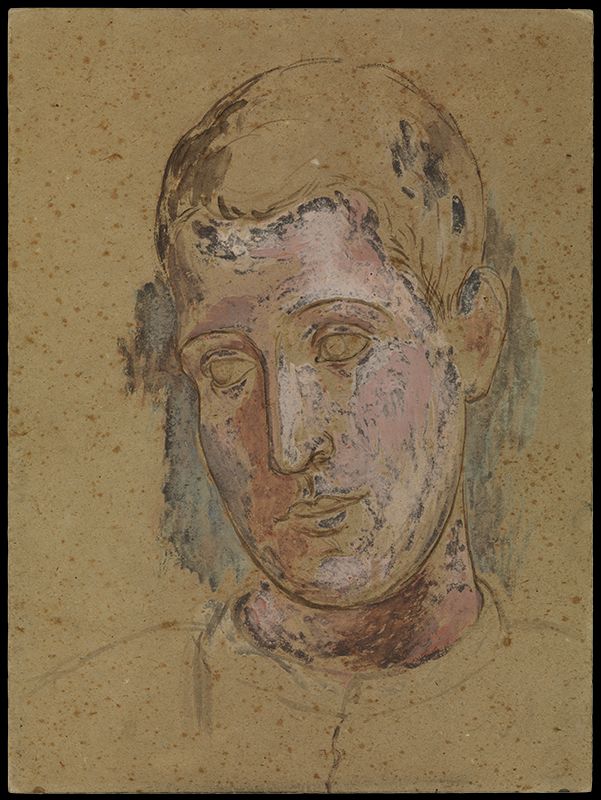Léonide Massine was the artistic name of Leonid Fyodorovich Miassinn, dancer and choreographer from the company of the Ballets Russes. Born in Moscow in 1896, he died in Cologne in 1979.
Photograph of Léonide Massine, 1920. Source: Picasso in Italia, Girorgio Cortenova, 1990. | Pablo Picasso. Harlequin. 1917. Oil on canvas. 116 x 90 cm. MPB 10.941
The Young Muscovite became the first dancer of the company of Ballets Russes of Serge Diaghilev, after having been contracted in the winter of 1913-1914 to substitute Vaslav Nijinsky. He made his debut as a dancer in Paris in 1914 with the work La Légende de Joseph and his first work as a choreographer was with Le Soleil de nuit, produced in 1915. Diaghilev supervised his artistic education: he took him to museums and concerts, and he introduced him to influential people such as the Russian painter Mikhail Larionov, the conductor Ernest Ansermet, and the composer Igor Stravinsky, thus influencing his evolution within the world of dance. Throughout his professional career he would end up directing the choreography of more than 50 ballets. In 1917 Picasso travelled to Italy with Jean Cocteau to work on the decorations, the backcloth and costumes of the ballet Parade, of the company of Diaghilev, in which Léonide Massini worked as choreographer. In May of that same year the ballet premiered in Paris and, subsequently, the company came to Barcelona. Picasso moved with the company. He had fallen in love with one of the dancers, Olga Kokhlova, who he got married to the next year. Picasso remained in the city between June and November 1917. It was then that he painted the Harlequin, the portrait of Massini.
Backcloth of Parade. París 1917. Musée National d’Art Moderne, Centre Georges Pompidou, Paris
The Commedia dell’Arte, and its actors in particular, had dominated the work of the artist since 1905 and continued to do so, with more or less intensity, throughout his creative process. Around 1917, a period of major contrasts in the work of Picasso would begin in his artistic production, in which the so-called classical or neo-classical works would combine with the creations which were still rooted in cubism. The work of the Harlequin is one of the first major exponents of this period. In 1919 Picasso gave the work to the Art Museums of Barcelona, the first of many donations he would give to the city. The creation of the Museu Picasso of Barcelona, inaugurated on March 9th 1963, would lead to the incorporation in the museum of the works of Picasso that belonged to the collections of the municipal museums, among which being the Harlequin.
Preliminary study of the work. Pablo Picasso. Harlequin head. 1917. Gouache on dark Brown cardboard. 30.5 x 22.8 cm. Donation by Pablo Picasso. 1970. MPB 110.231
Josep Palau i Fabre, in his book Picasso and his Catalan friends quoted a little anecdote, we don’t know if it’s true or not, related to the work: “Regarding the Harlequin of Barcelona I have heard mention various times that, after Picasso had made the donation to the city, the official services presented him with the invoice for the frame… It’s possible, very possible, but we haven’t been able to check the truth of this assertion.” The oil painting has formed part of many exhibitions, the last one being in 2013 in the National Gallery of Art de Washington, entitled "Diaghilev and the Ballets Russes, 1909 - 1929: When Art Danced with Music". Cristina Martín Community Manager References and links Picasso Museum. Guide. Claustre Rafart. Ajuntament de Barcelona. Institut de Cultura. Barcelona, 1998 Picasso in Italia. Giorgio Cortenova. Mazzota. Milano, 1990. Pages 80 and 90 Picasso i el Circ. Museu Picasso, Barcelona i Fondation Pierre Gianadda, Martigny. Institut de Cultura de Barcelona. Barcelona, 2006. Pages 38-41 and 56-64. “Ballets Russes”, a: Pierre Daix, Le nouveau dictionaire Picasso. París, Robert Laffont, 2012, pages. 86-87 "Arlequin", a: . Pierre Daix, Le nouveau dictionaire Picasso. París, Robert Laffont, 2012, pages 39-43 Picasso i els seus amics catalans by Palau i Fabre, Josep (1917-2008). Aedos. Barcelona, 1971. Pages 194-195 Diaghilev and the Ballet Russes, 1909-1929. When art danced with music. Jane Pritchard. Fundació "la Caixa". Barcelona, 2011 Information sheet about the work Harlequin in the website of the Museu Picasso Exhibition of the Museu Picasso of Barcelona “Picasso and the circus” (2006) Articles in the Wikipedia: Léonide Massine, Ballets Russes, Serge Diaghilev, Vaslav Nijinsky, Jean Cocteau, Commedia dell’Arte Article in the Encyclopædia Britannica: Leónide Massine The other inhabitants of the museum Blanquita Suárez, variety star Josefa Ruiz Blasco, Anut Pepa Sebastià Junyent, modernist painter Léonide Massine, the harlequin José Ruiz Picasso María Picasso Blasco Mª Dolores Ruiz Blasco Bendetta Canals Fernande Olivier Carles Casagemas Joan Vidal-Ventosa Reventós brothers





![Harlequin [Léonide Massine]](https://colleccions.eicub.net/api/1/images/https%3A%2F%2Fdobubt4dam3m5.cloudfront.net%2Fpublic%2FHeritageObject%2FH290821%2F142145%2Ffull%2Foriginal%2F0%2Fdefault.jpg)
![Head of a Harlequin [Léonide Massine]](https://colleccions.eicub.net/api/1/images/https%3A%2F%2Fdobubt4dam3m5.cloudfront.net%2Fpublic%2FHeritageObject%2FH290803%2F172940%2Ffull%2Foriginal%2F0%2Fdefault.jpg)



